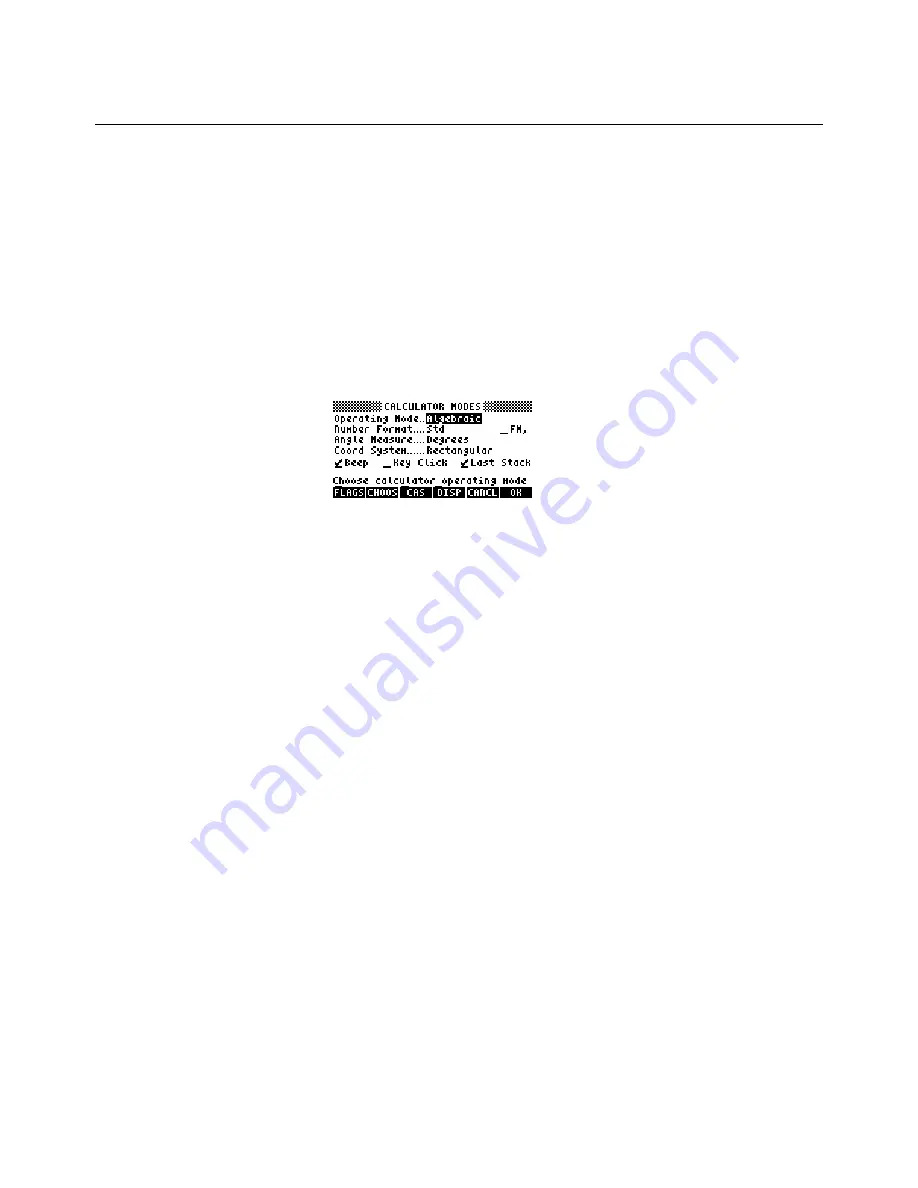
hp calculators
HP 48GII
Algebraic and RPN Operating Modes
Keys: First
Second
Third
Fourth
Fifth Sixth Seventh Eighth Ninth
Algebraic
!
Ü 6
+ 8
™
* 5 `
RPN
6
` 8
+ 5
*
In general, algebraic mode is better if you are using formulas you know, and if you just want to type them and get the results.
RPN mode is best if you want to go through calculations a step at a time, and sometimes even change your mind.
The HP48GII lets you use either mode. This training aid will show some examples of using Algebraic and RPN modes, and will
explain their differences and the advantages of each one.
Setting the mode
First make sure you know how to switch between algebraic and RPN modes. Press the
H
key and you will see the Modes Form.
Figure
3
When you open the Modes Form, the cursor is on the top line, which selects the Operating Mode, Algebraic or RPN, and this is
highlighted as in Figure 3 above. To change modes, press the
B
key below the
!CHOOS
menu label. You see the two options,
Algebraic and RPN. Use the up arrow key
—
or the down arrow key
˜
to select the mode you want. Then press the
F
key
below the
%OK%
menu label to confirm your selection, and press
%OK$
again to quit the Modes Form.
Tip!
A shortcut for switching between the two modes is to press
H
then
W
then
%OK$
. The
W
key switches between the
available choices, without the need for you to press
!CHOOS!
.
With the calculator is in Algebraic mode you see the letters ALG at the top right of the display screen, as in Figure 1. In RPN mode
this disappears, as in Figure 2.
For the examples below it will be helpful to have “Fix 2” and “Approximate” modes set too. First choose “Approximate” mode, so that
“exact” numbers such as 2/3 will be automatically converted to approximate results such as 0.666666666667. Press
H
then
C
below the
%CAS$
menu label to select the CAS Modes form. Press the down arrow key twice
˜˜
to reach the Approx
selection. If this already has a check mark by it, then you do not need to set it, so press the
E
key below the
!CANCEL
menu label.
If Approx is not checked then press
C
below the
%CHK$
menu label to select Approximate mode, and press
%OK$
to confirm the
setting. Now select “Fix 2” mode, to display answers with two digits after the decimal point, so you see 0.67 instead of
0.666666666667. Do this as follows: press
H
then
˜
to select the Number Format. Next press
!CHOOS!
then use the arrow keys
to pick FIXED and then press
%OK$
to choose Fixed mode. Then press the right arrow key
™
to choose the number of digits after
the decimal point. Press
!CHOOS!
again, select 2, and press
%OK$
to select Fix 2 mode. Finally press
%OK$
one more time to confirm
these selections.
Algebraic and RPN modes and the stack
As the example showed, both modes give the same answer. You just press keys in a different order. In Algebraic mode you type the
whole formula or expression, then press
`
and let the calculator work it all out. In RPN mode you give the calculator a number,
then tell it what to do with that number. Then you give it another number, or use the number you just got, and tell the calculator what
to do next. Clearly, Algebraic is good when you just want to type in a formula and get the answer. RPN is best if you want to work
through a problem, a step at a time, and see what is happening at each step, then decide what the next step is. This does not mean
that the calculator has to be used like this; many people use only Algebraic mode or only RPN for all their calculations.
hp calculators
- 3 -
HP 48GII
Algebraic and RPN Operating Modes








